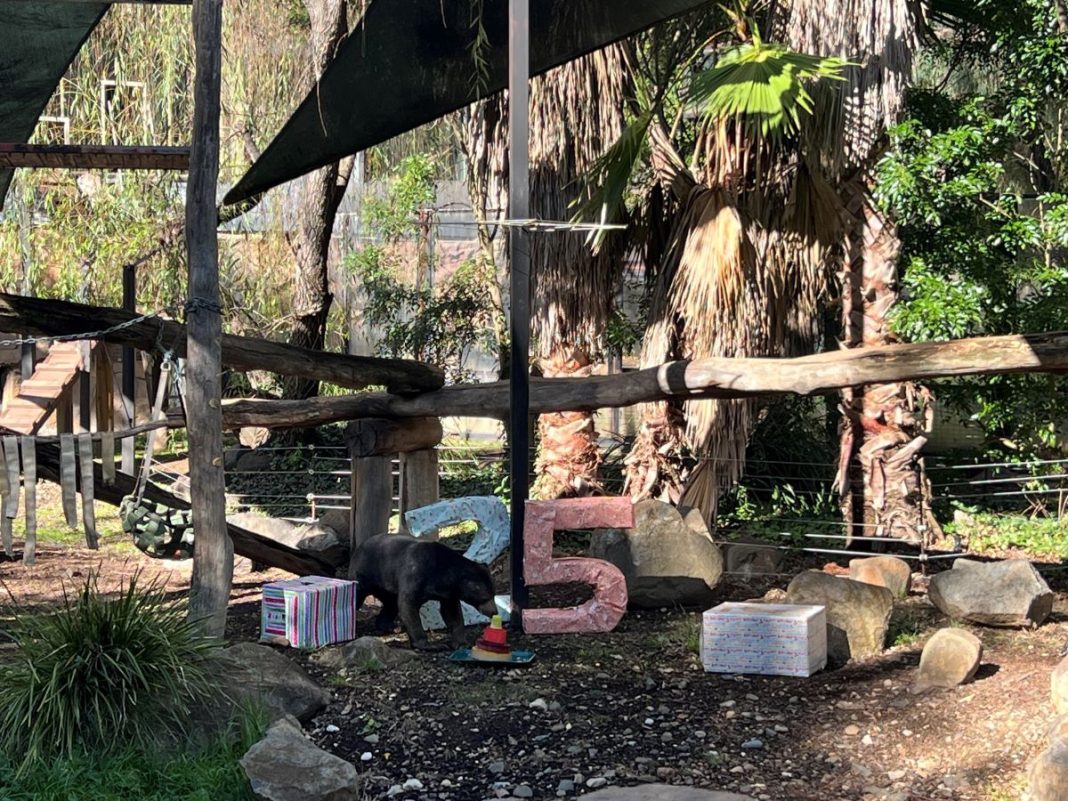Blowing out candles to the tune of ‘Happy Birthday’ was replaced by the knocking over of cakes and the roars of the lion as the National Zoo & Aquarium celebrated Arataki’s 25th birthday this morning. Born at Wellington Zoo, the Malaysian sun bear has spent most of his life here in Canberra with the zoo staff excited to celebrate this milestone.
“We’ve done a lot of big things for him, he’s got a four-tier birthday cake made of all of his favourite things; he’s got pumpkin, grapes, avocado, he’s had some nuts and some Weetabix and we made some big presents for him,” says Jemma Walsh, Zookeeper.
Hailing from Southeast Asia in the rainforests of the Malay Peninsula, Sumatra and Borneo, the sun bear stands around 1.2 metres tall and weighs under 70kg. An omnivore, the sun bear has powerful claws and a long tongue which it uses to eat termites, ants, beetles, larvae, honey and fruits.
Named after the yellow marking on its chest, not so much its sunny disposition, the sun bear is a territorial animal that if you compared pound for pound to any other bear, it would easily overpower.
“They are the smallest of the bear species but actually the most aggressive of the bear species, we say they have little bear syndrome,” smiles Ms Walsh.
Being a low-discovered species and the least studied of the bears, there are still a lot of uncertainties around the sun bears, like their life expectancy in the wild. However, in terms of captivity, Arataki is doing pretty well.
“In captivity, 25 is classified as an old bear, there have been some living up to about 30 but that is quite rare. So, at 25 he’s had a really good innings here at the zoo and hopefully many more years to come,” says Ms Walsh.
Currently considered an animal vulnerable to extinction, the striking bear is facing a number of threatening factors with more than 75 percent of their natural habitat lost to deforestation. Cubs are stolen from the wild to be used for bile farming, the restaurant trade or in circuses.
Unfortunately, for too many sun bears, life is short and painful as they are destined to remain imprisoned in steel and concrete chains until they’re required. Each paw will be cut off individually and served as a delicacy or their bile will be harvested for medicinal use.
“The illegal bile trade or the bear paw soup trade, it is still seen unfortunately in a lot of those traditional medicines as an important healing property,” says Ms Walsh.
One of the lucky ones Otay, Arataki’s lady companion, was rescued from the restaurant trade in 2007 by the Free the Bears Fund Incorporated. After a stay in one of the organisation’s sanctuaries, Otay was brought to the National Zoo to participate in a cooperative breeding program.
Arataki and Otay welcomed a female cub in 2010, named Mary after Mary Hutton, founder of Free the Bears. Unlike most bears, who are solitary in nature, Arataki and Otay enjoy each other’s company and spend most of their time together.
“Most other facilities that you would see, have housed them separately but these guys are besotted with each other. They love hanging out together Taks will go looking for Tay, we do have them together for the most part,” says Ms Walsh.
Together the sun bears have played a vital role as ambassadors for their species, Ms Walsh says the pair are a power team that have taught a lot of people about the species and raised a lot of funds.
“We’re really excited and proud to have had Arataki and Otay here for so many years, having had Otay come from that fate. They do amazing work for their species,”
One of the most popular enclosures for visitors to spend some time at on their visits, the sun bears hold a special place in the heart of the community.
“I think most of our members, our guests and even our staff can say that they’ve grown up with Taki for 25 years. It’s a pretty big achievement for us to have that but also pretty special for us to watch him as he’s grown up and be able to grow up with him,” says Ms Walsh.
Visit Arataki and the rest of the zoo residents 7 days a week, for more information visit; nationalzoo.com.au
Canberra Daily is keen to hear from you about a story idea in the Canberra and surrounding region. Click here to submit a news tip.



